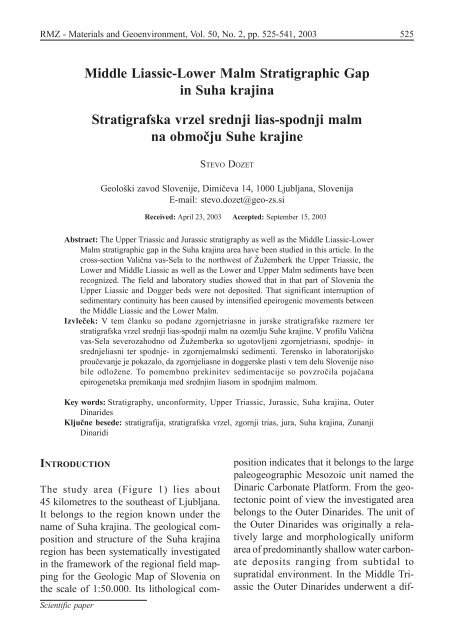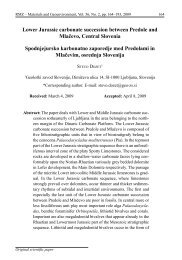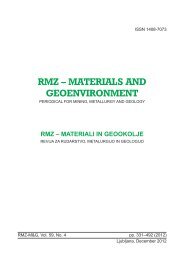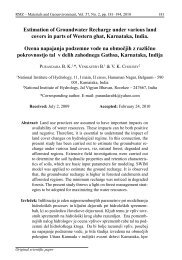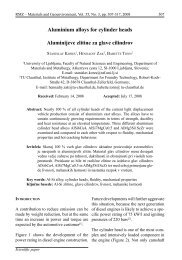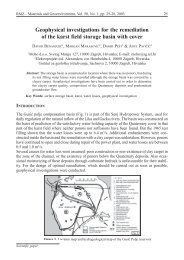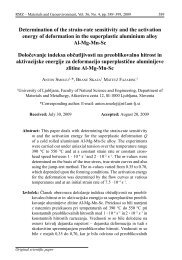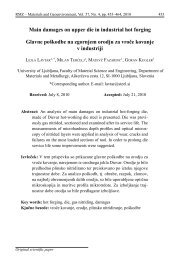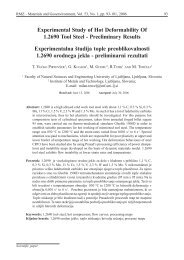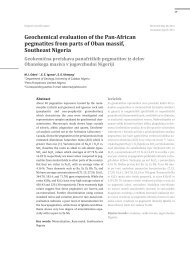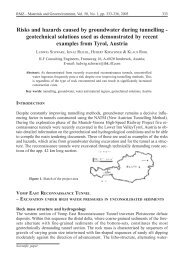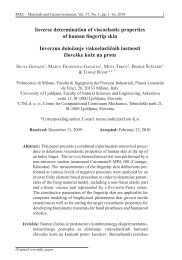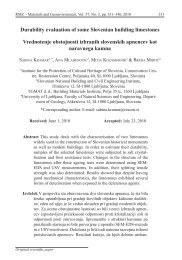Middle Liassic-Lower Malm Stratigraphic Gap in Suha krajina ... - RMZ
Middle Liassic-Lower Malm Stratigraphic Gap in Suha krajina ... - RMZ
Middle Liassic-Lower Malm Stratigraphic Gap in Suha krajina ... - RMZ
You also want an ePaper? Increase the reach of your titles
YUMPU automatically turns print PDFs into web optimized ePapers that Google loves.
<strong>RMZ</strong> - Materials and Geoenvironment, Vol� 50, No� 2, pp� 525-541, 2003 525<br />
<strong>Middle</strong> <strong>Liassic</strong>-<strong>Lower</strong> <strong>Malm</strong> <strong>Stratigraphic</strong> <strong>Gap</strong><br />
<strong>in</strong> <strong>Suha</strong> kraj<strong>in</strong>a<br />
Stratigrafska vrzel srednji lias-spodnji malm<br />
na obmoèju Suhe kraj<strong>in</strong>e<br />
STEVO DOZET<br />
Geološki zavod Slovenije, Dimièeva 14, 1000 Ljubljana, Slovenija<br />
E-mail: stevo�dozet@geo-zs�si<br />
Received: April 23, 2003 Accepted: September 15, 2003<br />
Abstract: The Upper Triassic and Jurassic stratigraphy as well as the <strong>Middle</strong> <strong>Liassic</strong>-<strong>Lower</strong><br />
<strong>Malm</strong> stratigraphic gap <strong>in</strong> the <strong>Suha</strong> kraj<strong>in</strong>a area have been studied <strong>in</strong> this article� In the<br />
cross-section Valièna vas-Sela to the northwest of Žužemberk the Upper Triassic, the<br />
<strong>Lower</strong> and <strong>Middle</strong> <strong>Liassic</strong> as well as the <strong>Lower</strong> and Upper <strong>Malm</strong> sediments have been<br />
recognized� The field and laboratory studies showed that <strong>in</strong> that part of Slovenia the<br />
Upper <strong>Liassic</strong> and Dogger beds were not deposited� That significant <strong>in</strong>terruption of<br />
sedimentary cont<strong>in</strong>uity has been caused by <strong>in</strong>tensified epeirogenic movements between<br />
the <strong>Middle</strong> <strong>Liassic</strong> and the <strong>Lower</strong> <strong>Malm</strong>�<br />
Izvleèek: V tem èlanku so podane zgornjetriasne <strong>in</strong> jurske stratigrafske razmere ter<br />
stratigrafska vrzel srednji lias-spodnji malm na ozemlju Suhe kraj<strong>in</strong>e� V profilu Valièna<br />
vas-Sela severozahodno od Žužemberka so ugotovljeni zgornjetriasni, spodnje- <strong>in</strong><br />
srednjeliasni ter spodnje- <strong>in</strong> zgornjemalmski sedimenti� Terensko <strong>in</strong> laboratorijsko<br />
prouèevanje je pokazalo, da zgornjeliasne <strong>in</strong> doggerske plasti v tem delu Slovenije niso<br />
bile odložene� To pomembno prek<strong>in</strong>itev sedimentacije so povzroèila pojaèana<br />
epirogenetska premikanja med srednjim liasom <strong>in</strong> spodnjim malmom�<br />
Key words: Stratigraphy, unconformity, Upper Triassic, Jurassic, <strong>Suha</strong> kraj<strong>in</strong>a, Outer<br />
D<strong>in</strong>arides<br />
Kljuène besede: stratigrafija, stratigrafska vrzel, zgornji trias, jura, <strong>Suha</strong> kraj<strong>in</strong>a, Zunanji<br />
D<strong>in</strong>aridi<br />
INTRODUCTION<br />
The study area (Figure 1) lies about<br />
45 kilometres to the southeast of Ljubljana�<br />
It belongs to the region known under the<br />
name of <strong>Suha</strong> kraj<strong>in</strong>a� The geological composition<br />
and structure of the <strong>Suha</strong> kraj<strong>in</strong>a<br />
region has been systematically <strong>in</strong>vestigated<br />
<strong>in</strong> the framework of the regional field mapp<strong>in</strong>g<br />
for the Geologic Map of Slovenia on<br />
the scale of 1:50�000� Its lithological com-<br />
Scientific paper<br />
position <strong>in</strong>dicates that it belongs to the large<br />
paleogeographic Mesozoic unit named the<br />
D<strong>in</strong>aric Carbonate Platform� From the geotectonic<br />
po<strong>in</strong>t of view the <strong>in</strong>vestigated area<br />
belongs to the Outer D<strong>in</strong>arides� The unit of<br />
the Outer D<strong>in</strong>arides was orig<strong>in</strong>ally a relatively<br />
large and morphologically uniform<br />
area of predom<strong>in</strong>antly shallow water carbonate<br />
deposits rang<strong>in</strong>g from subtidal to<br />
supratidal environment� In the <strong>Middle</strong> Triassic<br />
the Outer D<strong>in</strong>arides underwent a dif-
526 DOZET, S�<br />
ferentiation due to the formation of the<br />
Slovene trench, and soon the orig<strong>in</strong>ally uniform<br />
area was dissected <strong>in</strong>to two m<strong>in</strong>or platforms,<br />
the Julian and the D<strong>in</strong>aric one (BUSER,<br />
1989; RADOIÈIÆ, 1989)� Carbonate rocks were<br />
cont<strong>in</strong>uously deposited there from the Upper<br />
Triassic to the <strong>Lower</strong> Tertiary� The platform<br />
consisted of a very thick carbonate succession<br />
with an average thickness of about<br />
4000 m to 5000 m�<br />
Generally speak<strong>in</strong>g, the syngenetic<br />
paleotectonic events have controlled the paleogeographic<br />
evolution of the D<strong>in</strong>aric Carbonate<br />
Platform� The neotectonic processes<br />
uplift<strong>in</strong>g the study area, dictate the present<br />
position of the <strong>Suha</strong> kraj<strong>in</strong>a region�<br />
PREVIOUS INVESTIGATIONS<br />
<strong>Suha</strong> kraj<strong>in</strong>a was one of the least explored<br />
areas of Slovenia� The oldest data on geological<br />
structure of this region can be found<br />
<strong>in</strong> the articles of M�V� LIPOLD (1858)� ŽURGA<br />
(1938) was among first who described the<br />
geological structure of the Dolenjska district�<br />
In the notice on geological mapp<strong>in</strong>g of the<br />
Map Sheet Novo Mesto, GERMOVŠEK (1953,<br />
1956) mentioned among others the transgres-<br />
Figure 1� Location sketch map of the Valièna vas – Sela at Šumberk cross-section<br />
Slika 1� Položajna skica profila Valièna vas – Sela pri Šumberku<br />
<strong>RMZ</strong>-M&G 2003, 50
<strong>Middle</strong> <strong>Liassic</strong>-<strong>Lower</strong> <strong>Malm</strong> <strong>Stratigraphic</strong> <strong>Gap</strong> <strong>in</strong> <strong>Suha</strong> kraj<strong>in</strong>a 527<br />
sion of the Tithonian limestones upon the<br />
<strong>Liassic</strong> limestone <strong>in</strong> the area between<br />
Temenica and the upper stream of Krka� The<br />
transgressive <strong>Malm</strong> limestones conta<strong>in</strong> the<br />
typical Tithonian pseudooolitic-brecciated<br />
horizon�<br />
In the Trnovski gozd area the <strong>Liassic</strong> is represented<br />
by oolitic limestones with dolomite<br />
and micritic limestone <strong>in</strong>terbeds� The upper<br />
part of the oolitic succession belongs most<br />
probably already to Dogger� The oolitic limestone<br />
is transgressively overla<strong>in</strong> by the<br />
Tithonian coral and hydrozoan limestones�<br />
The Jurassic biostratigraphy of the area was<br />
dealt by GERMOVŠEK (1954), ŠRIBAR (1966)<br />
and TURNŠEK (1966, 1969, 1972)� BUSER<br />
(1968, 1974) reported that the Upper <strong>Liassic</strong><br />
and Dogger beds are not developed at<br />
Smrekova draga <strong>in</strong> the Trnovski gozd area,<br />
as well as <strong>in</strong> the area among Ivanèna gorica,<br />
Radohova vas and Trebnje�<br />
PLENIÈAR (1968) reported that <strong>in</strong> the<br />
Dolenjsko district <strong>in</strong> the area between Stièna,<br />
Šentvid, Radohova vas and Vel� Gaber the<br />
<strong>Malm</strong> beds lie transgressively upon the<br />
<strong>Middle</strong> <strong>Liassic</strong> ones�<br />
ŠRIBAR (1966) described the Jurassic sediments<br />
between Zagradec and Randol <strong>in</strong> the<br />
<strong>Suha</strong> kraj<strong>in</strong>a region� On the basis of microfossils<br />
and the stratigraphic position she divided<br />
the Jurassic succession <strong>in</strong>to the <strong>Lower</strong><br />
and <strong>Middle</strong> <strong>Liassic</strong>, Upper <strong>Liassic</strong>-Dogger,<br />
<strong>Lower</strong> <strong>Malm</strong>, and Upper <strong>Malm</strong>�<br />
In the comparatively small region of southern<br />
Slovenia TURNŠEK (1969) dist<strong>in</strong>guished<br />
three types of hydrozoan fauna formed dur<strong>in</strong>g<br />
the <strong>Lower</strong> <strong>Malm</strong> that are connected with<br />
<strong>RMZ</strong>-M&G 2003, 50<br />
three separated areas� These are the hydrozoan<br />
Cladocoropsis <strong>in</strong> the southern faunistic<br />
area, the parastromatoporidian Hydrozoa,<br />
corals and Chaetetidae <strong>in</strong> the central faunistic<br />
area, and the act<strong>in</strong>ostromaridian Hydrozoa<br />
<strong>in</strong> the northern faunistic area�<br />
The results of systematic regional geologic<br />
mapp<strong>in</strong>g on the map sheet Ribnica that comprises<br />
the study area as well, are presented <strong>in</strong><br />
the geological map on the scale of 100 000<br />
and its explanatory text by BUSER (1969, 1974)�<br />
PLENIÈAR AND PREMRU (1977) found that the<br />
limestone at Trebnje with the foram<strong>in</strong>ifer<br />
Lituosepta recoarensis (Cati) was overlaid<br />
discordantly by the <strong>Lower</strong> <strong>Malm</strong> sediments<br />
and that the Dogger rocks were absent�<br />
BUSER (1979) studied the geological circumstances<br />
on the Map Sheet Ribnica 1:100 000<br />
and divided the Jurassic succession <strong>in</strong> the<br />
lower (Oxfordian and <strong>Lower</strong> Kimmeridgian)<br />
and upper part (Upper Kimmeridgian and<br />
Tithonian)�<br />
Describ<strong>in</strong>g the geological structure of the<br />
Ribnica Map Sheet area BUSER (1974, 1979)<br />
mentioned the Jurassic (J 3 – J 1 ) transgressional<br />
boundary as well�<br />
BUKOVAC ET AL� (1984) presented a sedimentary<br />
and erosional reduction of the <strong>Liassic</strong>,<br />
Dogger and <strong>Lower</strong> <strong>Malm</strong> lithologic succession<br />
<strong>in</strong> the Èrnomelj Map Sheet area�<br />
The results of field and laboratory <strong>in</strong>vestigations<br />
<strong>in</strong> the study area were published <strong>in</strong><br />
the follow<strong>in</strong>g papers: STROHMENGER, DOZET<br />
& KOCH (1987 a, b), STROHMENGER (1988),<br />
STROHMENGER & DOZET (1991) and<br />
STROHMENGER, DEVILLE & FOOKES (1991)
528 DOZET, S�<br />
study<strong>in</strong>g the oolitic facies, stratigraphy, diagenesis,<br />
facies developments, the <strong>Malm</strong><br />
eustacy and geochemistry of the Jurassic<br />
carbonate rocks <strong>in</strong> <strong>Suha</strong> kraj<strong>in</strong>a� DOZET AND<br />
STROHMENGER (1996) described the Late<br />
<strong>Malm</strong> carbonate breccias at Kor<strong>in</strong>j discuss<strong>in</strong>g<br />
their significance for eustacy and tectonics�<br />
Shallow water deposits, breccias and<br />
subaerial exposures, evidenced by bauxite at<br />
some places <strong>in</strong> the <strong>Suha</strong> kraj<strong>in</strong>a region, are<br />
considered to be connected with eustatic sealevel<br />
variations as well as syn-sedimentary<br />
fractur<strong>in</strong>g and block-fault<strong>in</strong>g� DOZET (1995b)<br />
described various types of the <strong>Malm</strong> algal<br />
nodules (oncolites) from the <strong>Suha</strong> kraj<strong>in</strong>a<br />
region <strong>in</strong> the central Slovenia�<br />
In his dissertation STROHMENGER (1988) discussed<br />
microfacies and diagenetic development<br />
of the Jurassic carbonate rocks from<br />
the section Kompolje-Ogorelec at the Mala<br />
gora mounta<strong>in</strong> and the section Krka-Mali<br />
Kor<strong>in</strong>j <strong>in</strong> the <strong>Suha</strong> kraj<strong>in</strong>a region�<br />
STROHMENGER AND DOZET (1991) studied the<br />
stratigraphy, facies developments and<br />
geochemistry of the Jurassic carbonate rocks<br />
<strong>in</strong> <strong>Suha</strong> kraj<strong>in</strong>a� The field studies showed that<br />
at least the uppermost part of Dogger was<br />
not deposited there�<br />
STROHMENGER ET AL� (1991) compared the<br />
Upper Jurassic stratigraphy and the facies<br />
development of the D<strong>in</strong>aric Carbonate Platform<br />
of Slovenia with the Jurassic Carbonate<br />
Platform of southern Jura (southeastern<br />
France)� The <strong>Malm</strong> discont<strong>in</strong>uity is <strong>in</strong>terpreted<br />
as represent<strong>in</strong>g a large-scale sequence<br />
boundary, probably of type 1, (black pebble<br />
conglomerate: France; reef breccia: Switzerland;<br />
karst breccia: Slovenia)�<br />
DOZET (1993) detected the complete Lofer<br />
cyclothems <strong>in</strong> the <strong>Lower</strong> <strong>Liassic</strong> beds from<br />
the Slovenian part of the Outer D<strong>in</strong>arides�<br />
BUSER AND DEBELJAK (1996) studied the distribution<br />
of lithiotids <strong>in</strong> the Jurassic beds of<br />
south Slovenia� The horizon with bivalves<br />
(lithiotid horizon) is attributed to<br />
Ple<strong>in</strong>sbachian (Domerian)� The most <strong>in</strong>terest<strong>in</strong>g<br />
are three large bivalve species:<br />
Lithiotis problematica Gümbel, Cochlearites<br />
loppianus (Tausch) and Lithiopedalion<br />
scutatus (Dubar)� In addition, the follow<strong>in</strong>g<br />
genera can be found: Gervilleioperna,<br />
Mytilus, Opisoma and Pachyrisma (with subgenera<br />
Pachymegalodon and Durga)�<br />
DEBELJAK AND BUSER (1998) ranged the horizon<br />
conta<strong>in</strong><strong>in</strong>g the <strong>Middle</strong> <strong>Liassic</strong> bivalves,<br />
the so called “lithiotid horizon”, <strong>in</strong>to the<br />
Pliensbachian or Domerian�<br />
DOZET AND ŠRIBAR (1998) lithologically described<br />
and biostratigraphically subdivided<br />
the shallow mar<strong>in</strong>e Jurassic beds <strong>in</strong> the southeastern<br />
Slovenia�<br />
METHODS<br />
This study is based on the systematic regional<br />
geological mapp<strong>in</strong>g for the Geological Map<br />
of Slovenia on the scale of 1:50 000 as well<br />
as several detailed field surveys <strong>in</strong>clud<strong>in</strong>g<br />
stratimetric measur<strong>in</strong>g and profil<strong>in</strong>g as well<br />
as a precise sedimentological and facies<br />
study of the Jurassic rocks <strong>in</strong> the considered<br />
area� Moreover, the whole area is docu-<br />
<strong>RMZ</strong>-M&G 2003, 50
<strong>Middle</strong> <strong>Liassic</strong>-<strong>Lower</strong> <strong>Malm</strong> <strong>Stratigraphic</strong> <strong>Gap</strong> <strong>in</strong> <strong>Suha</strong> kraj<strong>in</strong>a 529<br />
mented by rock samples, numerous th<strong>in</strong>-sections<br />
and geochemical analyses� The stratigraphic<br />
relationships have been established<br />
by means of micro- and macrofossils as well<br />
as lithological and biostratigraphical correlations�<br />
The carbonate rocks are classified<br />
accord<strong>in</strong>g to FOLK’S (1959) practical petrographic<br />
classification of limestones and<br />
DUNHAM’S (1962) classification of carbonate<br />
rocks accord<strong>in</strong>g to depositional texture�<br />
The microfauna and microflora are determ<strong>in</strong>ed<br />
by Ljudmila Šribar and Rajka<br />
Radoièiæ� Hydrozoans, sponges and corals<br />
are determ<strong>in</strong>ed by Dragica Turnšek� The<br />
colour determ<strong>in</strong>ations of the rocks are based<br />
on the Munsell Rock Colour Chart�<br />
STRATIGRAPHY<br />
The study area is built of the Triassic and Jurassic<br />
rocks, which are at many places covered<br />
with a couple of metres of the Pliocene<br />
and Quaternary deposits� The Triassic system<br />
is represented by the Ma<strong>in</strong> Dolomite, which<br />
is overla<strong>in</strong> by the Rhaetian-<strong>Liassic</strong> carbonate<br />
succession� The Jurassic beds are not completely<br />
developed� The up to the present gathered<br />
data show the lack of the Upper <strong>Liassic</strong><br />
and the Dogger beds� The above-mentioned<br />
Triassic and Jurassic beds are the result of<br />
more or less cont<strong>in</strong>uous sedimentation on the<br />
D<strong>in</strong>aric Carbonate Platform�<br />
STRATIGRAPHY OF THE SEDIMENTARY<br />
SUCCESSION UNDERLYING<br />
THE MIDDLE LIASSIC-LOWER<br />
MALM UNCONFORMITY<br />
The sedimentary succession exposed at the<br />
surface <strong>in</strong> the <strong>Suha</strong> kraj<strong>in</strong>a area and ly<strong>in</strong>g<br />
<strong>RMZ</strong>-M&G 2003, 50<br />
under the <strong>Middle</strong> <strong>Liassic</strong>-<strong>Lower</strong> <strong>Malm</strong><br />
unconformity range <strong>in</strong> age from the Upper<br />
Triassic to the <strong>Middle</strong> <strong>Liassic</strong> belong<strong>in</strong>g to<br />
two pretty widely exposed formations,<br />
namely: the Ma<strong>in</strong> Dolomite and the Rhaetian<br />
and <strong>Liassic</strong> Beds (Fig� 2, Fig� 3)�<br />
Ma<strong>in</strong> Dolomite Formation<br />
About 2000 metres thick Triassic rock succession<br />
<strong>in</strong> Southern Slovenia lies<br />
transgressively upon the Permo-Carboniferous<br />
and Permian beds (BUSER, 1974; DOZET,<br />
1985; SAVIÆ ET AL�, 1982)�<br />
The Upper Triassic beds are developed as<br />
800 to 1000 metres thick succession of carbonate<br />
rocks, known as the Ma<strong>in</strong> Dolomite<br />
or Hauptdolomit, deposited on the vast stable<br />
carbonate platform of the Outer D<strong>in</strong>arides<br />
show<strong>in</strong>g the Lofer development� Sedimentary<br />
structures, geochemical data and fossils<br />
<strong>in</strong>dicate a sedimentation <strong>in</strong> a quiet restricted<br />
shelf with numerous signs of littoral conditions�<br />
M<strong>in</strong>eralogical and chemical analyses<br />
show that the dolomite is very pure with<br />
stechiometric composition� Stromatolitic and<br />
loferitic layers were subjected to an early<br />
dolomitization with capilary processes� Other<br />
layers were dolomitized after deposition�<br />
In spite of monotonous outer aspect the Ma<strong>in</strong><br />
Dolomite shows a pretty heterogeneous<br />
microfacial composition� Be<strong>in</strong>g formed <strong>in</strong><br />
changeable littoral and sublittoral conditions<br />
the Ma<strong>in</strong> Dolomite shows numerous<br />
lithological varieties, which are characteristic<br />
for <strong>in</strong>tertidal and supratidal environments�<br />
These are stromatolitic layers, loferites, lam<strong>in</strong>ated<br />
carbonate rocks as well as tidal conglomerates<br />
<strong>in</strong> different varieties and<br />
<strong>in</strong>terweav<strong>in</strong>gs�
530 DOZET, S�<br />
Figure 2� Shematic geological column <strong>in</strong> the level of the Jurassic stratigraphic gap, the underly<strong>in</strong>g<br />
<strong>Middle</strong> <strong>Liassic</strong> and the overly<strong>in</strong>g <strong>Lower</strong> <strong>Malm</strong> beds<br />
Slika 2� Shematski geološki stolpec v predelu jurske stratigrafske vrzeli ter spodaj ležeèih<br />
srednjeliasnih <strong>in</strong> zgoraj ležeèih spodnjemalmskih plasti<br />
<strong>RMZ</strong>-M&G 2003, 50
<strong>Middle</strong> <strong>Liassic</strong>-<strong>Lower</strong> <strong>Malm</strong> <strong>Stratigraphic</strong> <strong>Gap</strong> <strong>in</strong> <strong>Suha</strong> kraj<strong>in</strong>a 531<br />
Rhaetian and <strong>Liassic</strong> Beds<br />
The Ma<strong>in</strong> Dolomite be<strong>in</strong>g most extended <strong>in</strong><br />
the Valièna vas-Sela area passes upwards <strong>in</strong>to<br />
pretty heterogeneous carbonate succession<br />
rang<strong>in</strong>g <strong>in</strong> age from the Uppermost Triassic<br />
to the <strong>Middle</strong> <strong>Liassic</strong>�<br />
The Rhaetian-<strong>Liassic</strong> carbonate succession<br />
has a heterogeneous composition, be<strong>in</strong>g<br />
composed of lam<strong>in</strong>ated dolomite and limestone,<br />
micritic and biomicritic limestone,<br />
dolomitized limestone as well as dolomitic<br />
and dolomitic-calcareous breccias� In the<br />
lower and middle part of the described sedimentary<br />
succession dolomites prevail,<br />
whereas <strong>in</strong> the upper part limestones are most<br />
common�<br />
<strong>RMZ</strong>-M&G 2003, 50<br />
Figure 3� Legend<br />
Slika 3� Legenda<br />
The dolomites are well-stratified (10-35 cm)<br />
or platy (5 cm), f<strong>in</strong>e and coarse-gra<strong>in</strong>ed, very<br />
light grey, light grey, and occasionally very<br />
light brownish grey� In the lower part of the<br />
succession <strong>in</strong>tercalations of grey and dark<br />
grey middle to coarse-gra<strong>in</strong>ed dolomite<br />
appear� Lam<strong>in</strong>ated and stromatolitic dolomites<br />
are often observed <strong>in</strong> the lower and<br />
middle part of the Rhaetian-<strong>Liassic</strong><br />
lithological column�<br />
The limestones are thick-bedded (35-150<br />
cm) belong<strong>in</strong>g to the light brownish grey<br />
micrite, rarely biomicrite� At some places<br />
very light grey, light grey and medium grey,<br />
thick-bedded, lam<strong>in</strong>ated, micritic limestone<br />
occurs with some centimetres solution cavities<br />
filled with white calcite� Among the de-
532 DOZET, S�<br />
scribed limestones there are very light grey,<br />
platy (5 cm) and stratified (10-35 cm) more<br />
or less dolomitized limestones� Occasionally,<br />
red and p<strong>in</strong>k strongly dolomitized limestones<br />
with some mm to some cm large cavities<br />
filled with calcite occur <strong>in</strong> the considered<br />
sedimentary succession�<br />
Dolomitic and dolomitic-calcareous breccias<br />
are very light grey, light grey and moderate<br />
light grey, hav<strong>in</strong>g heterogeneous composition�<br />
They are composed of 3 cm to 4 cm,<br />
rarely up to 15 cm big angular fragments of<br />
moderate grey, micritic to f<strong>in</strong>e-gra<strong>in</strong>ed dolomite,<br />
brownish and somewhat bitum<strong>in</strong>ous<br />
dolomite, light grey lam<strong>in</strong>ated dolomite as<br />
well as stromatolitic dolomite with frequent<br />
shr<strong>in</strong>kage pores and fissures�<br />
The age of the described dolomite column is<br />
def<strong>in</strong>ed accord<strong>in</strong>g to micro and macro fossils<br />
as well as its stratigraphic position�<br />
In the carbonate rocks of the lower part of<br />
the Rhaetian and <strong>Liassic</strong> lithologic sequence<br />
the algae Palaeoedasycladus sp�, foram<strong>in</strong>ifers<br />
Lagenidae, Lituolidae, Textulariidae and<br />
Verneuil<strong>in</strong>idae as well as gastropod and<br />
brahiopod rema<strong>in</strong>s have been ascerta<strong>in</strong>ed� In<br />
the similar beds <strong>in</strong> the quarry St� Ana at<br />
Mirna Peè the foram<strong>in</strong>ifer Haurania deserta<br />
Henson has been recognized� The above-enumerated<br />
fauna po<strong>in</strong>t at the <strong>Lower</strong> <strong>Liassic</strong> age<br />
of sediments�<br />
More rich <strong>in</strong> fossils are the sediments of upper<br />
part of the Rhaetian-<strong>Liassic</strong> carbonate<br />
succession <strong>in</strong> the cross-section Valièna vas-<br />
Sela conta<strong>in</strong><strong>in</strong>g algae Palaeodasycladus<br />
mediterraneus Pia, Thaumatoporella<br />
parvovesiculifera (Ra<strong>in</strong>eri), Aeolissaccus<br />
sp�, and nonskeletal blue-green algae, foram<strong>in</strong>ifers<br />
Oribtopsella praecursor (Gümbel),<br />
Lituosepta recoarensis (Cati), Vidal<strong>in</strong>a<br />
martana Far<strong>in</strong>acci, Glomospira sp�,<br />
Opthalmidiidae, Textulariidae and<br />
Lagenidae� Rare sections of Favre<strong>in</strong>a<br />
salevensis (Paréjas) can also be seen� In the<br />
Rhaetian-<strong>Liassic</strong> lithologic sequence rare<br />
megalodontid lumachelles occur as well� The<br />
lithiotid horizon with the thickness of 5<br />
metres is poorly developed�<br />
MIDDLE LIASSIC-LOWER<br />
MALM UNCONFORMITY<br />
The paleontological data clearly <strong>in</strong>dicate that<br />
the <strong>Middle</strong> <strong>Liassic</strong>-<strong>Lower</strong> <strong>Malm</strong> contact represent<br />
<strong>in</strong> fact an unconformity� However,<br />
along the contact there are no signs of angle<br />
discordance or larger transgression� Only a<br />
th<strong>in</strong> layer of a red clay can be seen upon the<br />
contact surface at some places� The red clay<br />
and fossils <strong>in</strong>dicate a substantial break or<br />
gap <strong>in</strong> the geologic record result<strong>in</strong>g from a<br />
change that caused the deposition to cease<br />
for a considerable span of time imply<strong>in</strong>g an<br />
uplift and erosion with loss of the previously<br />
formed sediments�<br />
STRATIGRAPHY OF THE SEDIMENTARY<br />
SUCCESSION OVERLYING<br />
THE MIDDLE LIASSIC-LOWER<br />
MALM UNCONFORMITY<br />
The considered sedimentary succession (Figure<br />
2, Figure 3) starts with beds of breccoid<br />
limestone, limestone and calcareous breccia;<br />
upwards follow oolitic, bioclastic and reef<br />
<strong>RMZ</strong>-M&G 2003, 50
<strong>Middle</strong> <strong>Liassic</strong>-<strong>Lower</strong> <strong>Malm</strong> <strong>Stratigraphic</strong> <strong>Gap</strong> <strong>in</strong> <strong>Suha</strong> kraj<strong>in</strong>a 533<br />
limestones� In the lower part of the oolitic<br />
limestone an horizon of predom<strong>in</strong>antly<br />
micritic limestone with chert occur�<br />
The sedimentary succession overly<strong>in</strong>g the<br />
<strong>Middle</strong> <strong>Liassic</strong>-<strong>Lower</strong> <strong>Malm</strong> unconformity<br />
ranges <strong>in</strong> age from the <strong>Lower</strong> to the Upper<br />
<strong>Malm</strong> <strong>in</strong>volv<strong>in</strong>g the Orlaka Limestone with<br />
chert and <strong>in</strong> the preface mentioned oolitic,<br />
bioclastic, reef as well as T<strong>in</strong>t<strong>in</strong>n<strong>in</strong>a and<br />
Clype<strong>in</strong>a carbonate rocks�<br />
Orlaka Limestone with chert<br />
The Orlaka Limestone with chert rests with<br />
great unconformity upon the <strong>Middle</strong> <strong>Liassic</strong><br />
carbonate rocks�<br />
Limestone with chert is usually grey and<br />
moderate dark grey� From the textural po<strong>in</strong>t<br />
of view it belongs to <strong>in</strong>trasparitic,<br />
bio<strong>in</strong>trasparitic, micritic, pelmicritic,<br />
oo<strong>in</strong>trasparitic and bioclastic limestones conta<strong>in</strong><strong>in</strong>g<br />
fragments and detritus of hydrozoans<br />
and molluscs� The treated limestone<br />
show clear stratification (25-50 cm) be<strong>in</strong>g<br />
commonly platy and th<strong>in</strong>- bedded (2-20 cm)<br />
and conta<strong>in</strong><strong>in</strong>g lenses and th<strong>in</strong> layers of grey,<br />
yellowish grey and moderate dark grey dotted<br />
chert�<br />
The limestones with chert at Orlaka is underla<strong>in</strong><br />
by several metres thick biohermal<br />
reef limestone with hydrozoans and ech<strong>in</strong>oids�<br />
Accord<strong>in</strong>g to BUSER (1974) the limestone<br />
with chert at Orlaka is, tak<strong>in</strong>g <strong>in</strong>to account<br />
its stratigraphical position and<br />
lithological composition, an equivalent of the<br />
limestone with chert at Trnovo forest, which<br />
also underlies the reef limestones� In the<br />
limestone with chert at Trnovo forest<br />
<strong>RMZ</strong>-M&G 2003, 50<br />
Radoièiæ (BUSER, 1978) determ<strong>in</strong>ed the follow<strong>in</strong>g<br />
fossil association: Protopeneroplis<br />
striata Weynschenk, Nautilocul<strong>in</strong>a oolithica<br />
Mohler, Textularia cf� agglut<strong>in</strong>ans, Discorbis<br />
acutuliformis, Thaumatoporella parvovesiculifera<br />
(Ra<strong>in</strong>eri), Bac<strong>in</strong>ella sp� as well<br />
as algal and to algae similar structures� The<br />
variegated microfossil association <strong>in</strong>dicates<br />
that the limestone with chert from Trnovo<br />
forest belongs to the lower part of <strong>Malm</strong>,<br />
Oxfordian respectively�<br />
Shelf and reef carbonate rocks<br />
In the <strong>Malm</strong> period a differentiation of formerly<br />
uniform shallow shelf area progressively<br />
cont<strong>in</strong>ued� In the Dolenjska district<br />
already at the beg<strong>in</strong>n<strong>in</strong>g of <strong>Malm</strong> barrier reef,<br />
back-reef and restricted shelf with lagoon<br />
were formed� TURNŠEK (1966, 1969) came to<br />
the conclusion, that three areas and hydrozoan<br />
types were formed <strong>in</strong> a comparatively<br />
small region of the southern Slovenia,<br />
namely: the hydrozoan Cladocoropsis <strong>in</strong> the<br />
southern faunistic area, parastromatoporidian<br />
hydrozoans, corals and chaetetids <strong>in</strong> the<br />
middle faunistic area and actionostromaridian<br />
hydrozoans <strong>in</strong> the northern faunistic<br />
area� Different hydrozoan types had<br />
developed because of somewhat different<br />
ecologic conditions prevalent <strong>in</strong> each of these<br />
areas� The areas with <strong>in</strong>dividual faunistic<br />
types follow each other <strong>in</strong> narrow and long<br />
belts extend<strong>in</strong>g from the southeast to northwest,<br />
a fact, which leads us to supposition<br />
that they followed either a former direction<br />
of shore or a course of some submar<strong>in</strong>e shelf�<br />
The <strong>Lower</strong> <strong>Malm</strong> beds, exposed among<br />
Radohova vas, Muljava and Orlaka are composed<br />
of light grey moderate grey, light
534 DOZET, S�<br />
brownish grey, grey, and rarely moderate<br />
dark grey micritic, biomicritic, biolithitic,<br />
coarse-gra<strong>in</strong>ed bioclastic, bio<strong>in</strong>trasparitic<br />
and oolitic limestones, limestones with chert,<br />
bioclastic limestones as well as reef breccias�<br />
The oolitic limestones are made of radial,<br />
micritic and tangential ooids, fossil rema<strong>in</strong>s<br />
and detritus bound together with a sparitic<br />
carbonate cement� They are massive or thickbedded,<br />
moderate grey and commonly crossbedded�<br />
From the structural po<strong>in</strong>t of view<br />
the at first sight monotonous carbonate succession<br />
is composed of oosparites,<br />
oo<strong>in</strong>trasaprites and bioosparites� The oolitic<br />
limestones orig<strong>in</strong>ated from the transport of<br />
the ooid sand and fossil detritus, carried by<br />
tidal streams and waves, deposited on a tidal<br />
sand bar�<br />
The reef limestones are sediments consist<strong>in</strong>g<br />
of rema<strong>in</strong>s of the Jurassic reef-build<strong>in</strong>g<br />
organisms such as hydrozoans, corals,<br />
sponges, bryozoans, chaetetids, ech<strong>in</strong>oids,<br />
gastropods, pelecypods, and of sedimentb<strong>in</strong>d<strong>in</strong>g<br />
organic constituents such as calcareous<br />
algae� S<strong>in</strong>ce the treated limestones are<br />
made up <strong>in</strong> large part of skeletons of hydrozoans<br />
they are called hydrozoan reefs� Relatively<br />
frequent occurrences of biolithite of<br />
biohermal type, the mode of occurrences and<br />
distribution of the reef limestones <strong>in</strong> the<br />
Dolenjska district and broader <strong>in</strong> the Outer<br />
D<strong>in</strong>arides <strong>in</strong>dicate large reefs of barrier type<br />
(BUSER, 1974)�<br />
Hydrozoan fauna was the most important<br />
reef builder and belongs to the north faunistic<br />
area (TURNŠEK, 1969)� Among hydrozoans<br />
Sphaeract<strong>in</strong>idae with genera<br />
Sphaeract<strong>in</strong>ia and Ellipsact<strong>in</strong>ia prevail;<br />
however, pretty numerous were also another<br />
hydrozoans from the group of Act<strong>in</strong>ostromariicae�<br />
For this reason TURNŠEK (1969)<br />
named the hydrozoans of the northern area<br />
the actionostromariid type� Accord<strong>in</strong>g to<br />
TURNŠEK, (1966, 1969) the northern area was<br />
<strong>in</strong> the early Jura a long, relatively narrow<br />
reef, extend<strong>in</strong>g from Nemci and Ojstrovec<br />
across Trnovski gozd and Ljubljansko barje<br />
to Maèkovec and Bela kraj<strong>in</strong>a� S<strong>in</strong>ce the Jurassic<br />
rocks with hydrozoans were recently<br />
exposed only <strong>in</strong> the Trnovski gozd (Trnovo<br />
forest) and Dolenjsko district as well as at<br />
Ivanèna gorica towards the south and southeast,<br />
and because of the similar fauna <strong>in</strong> both<br />
areas she concluded, there was a uniform<br />
hydrozoan reef, which was later <strong>in</strong>terrupted<br />
by late tectonic movements and at some<br />
places partly elevated or partly sunk� At Dob<br />
and Stièna gora from the Dolenjsko district<br />
the follow<strong>in</strong>g hydrozoan species were determ<strong>in</strong>ed<br />
by Turnšek: Astrostylopsis tubulata,<br />
A� trnovica, Act<strong>in</strong>ostrom<strong>in</strong>a germovsheki,<br />
Desmopora listigonorum, Cylopsis florida,<br />
C� lata, Cylopsis sp�, Coenostella thomasi<br />
and Sphaeract<strong>in</strong>idae�<br />
Beside enumerated macrofauna the reef limestones<br />
conta<strong>in</strong> the follow<strong>in</strong>g microfossils,<br />
determ<strong>in</strong>ed by Lj� Šribar: Nautilocul<strong>in</strong>a<br />
oolithica Mohler, Glomospira sp�,<br />
Trochol<strong>in</strong>a sp�, Nodobacularia sp�,<br />
Aeolisaccus sp�, Chit<strong>in</strong>oidella sp�, Tubiphytes<br />
sp�, Codiaceae, Ophthalmidiidae and<br />
Textulariidae as well as the sponge<br />
Cladocoropsis sp� The whole association<br />
proves the <strong>Lower</strong> <strong>Malm</strong> age�<br />
The basic build<strong>in</strong>g and lithologic element of<br />
the whole reef complex was light, moderate<br />
light grey, grey, rarely dark grey and strati-<br />
<strong>RMZ</strong>-M&G 2003, 50
<strong>Middle</strong> <strong>Liassic</strong>-<strong>Lower</strong> <strong>Malm</strong> <strong>Stratigraphic</strong> <strong>Gap</strong> <strong>in</strong> <strong>Suha</strong> kraj<strong>in</strong>a 535<br />
fied, usually massive, biolithitic limestone<br />
composed of skeleton of different reef build<strong>in</strong>g<br />
organisms among which sphaeract<strong>in</strong>ids,<br />
act<strong>in</strong>ostromariids, hydrozoans and blue green<br />
algae prevail�<br />
Relatively very extended rocks <strong>in</strong> the study<br />
area are bioclastic carbonate rocks, composed<br />
of extremely strong recrystallized fragments<br />
of fossils of ruditic size and partly recrystallized<br />
dark grey and greyish black<br />
prevalently micritic, biomicritic and<br />
dismicritic <strong>in</strong>traclasts as well as numerous<br />
round and oval pellets� Among fossil fragments<br />
ruditic fragments of ech<strong>in</strong>oderms<br />
strongly prevail� The groundmass of these<br />
rocks consists of coarse-gra<strong>in</strong>ed sparry calcite,<br />
rarely of matrix� Among noncarbonate<br />
rocks clay admixture is predom<strong>in</strong>ant�<br />
Bioclastic carbonate rocks orig<strong>in</strong>ated by destruction<br />
of smaller and larger very extended<br />
reef bodies� The most important reef build<strong>in</strong>g<br />
organisms were hydrozoans, sponges,<br />
corals, algae, ech<strong>in</strong>oderms and pelecypods�<br />
After consolidation bio<strong>in</strong>trasparuditic limestones<br />
were submitted to extremely strong<br />
latediagenetic changes such as recrystallization,<br />
cementation and dolomitization� Selective<br />
late dolomitization, was present <strong>in</strong> different<br />
levels of the reef complex� Consequently,<br />
smaller and larger patches of coarsegra<strong>in</strong>ed<br />
latediagenetic dolomite occur <strong>in</strong> the<br />
reef complex� Bio<strong>in</strong>trasparuditic limestone<br />
is usually massive� Clear stratification with<br />
5-65 cm thick beds can rarely be seen� In<br />
these sediments a cross-stratification can also<br />
be observed�<br />
Reef breccias appear <strong>in</strong> the fore-reef area�<br />
They are composed of fragments and blocks<br />
<strong>RMZ</strong>-M&G 2003, 50<br />
of biolithitic and bio<strong>in</strong>trasparuditic limestones<br />
with sections and fragments of hydrozoan<br />
colonies� The fragments were broken<br />
from the reef by action of waves and tides�<br />
On the basis of up to this time collected data<br />
we can say, the considered <strong>Lower</strong> <strong>Malm</strong> sedimentary<br />
succession was formed on an elongated<br />
reef pretty far from the shore� The basic<br />
reef build<strong>in</strong>g element was the biolithitic<br />
limestone� The bio<strong>in</strong>tracalcirudites and<br />
biocalcarenites were deposited <strong>in</strong> the backreef<br />
shallow sea, whereas the reef breccias<br />
were accumulated <strong>in</strong> the fore-reef area�<br />
Clype<strong>in</strong>a and T<strong>in</strong>t<strong>in</strong>n<strong>in</strong>a limestones<br />
The <strong>Lower</strong> <strong>Malm</strong> reef and perireef limestones<br />
<strong>in</strong> the Sela-Šumberk-Dobrniè area<br />
pass towards northeast and north <strong>in</strong>to the<br />
Upper <strong>Malm</strong> sedimentary succession, which<br />
comprises the Upper Kimmeridgian and<br />
Portlandian Clype<strong>in</strong>a and T<strong>in</strong>t<strong>in</strong>n<strong>in</strong>a limestones�<br />
The <strong>Lower</strong> <strong>Malm</strong> succession is overla<strong>in</strong><br />
there by lam<strong>in</strong>ated, stromatolitic,<br />
oncolitic, micritic and bio<strong>in</strong>trasparitic limestones,<br />
patch reefs as well as early and<br />
latediagenetic dolomites and carbonate breccias�<br />
The treated beds are characterized by a<br />
rhythmic sedimentation� The color of the<br />
beds is mostly grey and light grey� From the<br />
structural po<strong>in</strong>t of view calcarenites and<br />
calcirudites prevail� The considered sedimentary<br />
succession is massive or stratified� The<br />
limestones and calcareous dolomites conta<strong>in</strong><br />
a fossil fauna and flora� The most numerous<br />
fossils are clype<strong>in</strong>as and t<strong>in</strong>t<strong>in</strong>n<strong>in</strong>s� However,<br />
hydrozoans, sponges, gastropods, pelecypods<br />
as well as other molluscs also occur�<br />
The age of the treated lithological column is<br />
determ<strong>in</strong>ed by the follow<strong>in</strong>g microfossils:
536 DOZET, S�<br />
Clype<strong>in</strong>a jurassica Favre and the t<strong>in</strong>t<strong>in</strong>n<strong>in</strong><br />
Campbelliella milesi milesi Radoièiæ� Beside<br />
these two fossils still Kurnubia palast<strong>in</strong>iensis<br />
Henson, Salp<strong>in</strong>goporella annulata Carozzi,<br />
Favre<strong>in</strong>a salevensis Paréjas, Qu<strong>in</strong>quelocul<strong>in</strong>a<br />
sp�, Faveloides� sp�, Trocham<strong>in</strong>idae,<br />
Textulariidae, Verneuil<strong>in</strong>idae, Ophthalmidiidae,<br />
Codiaceae, ech<strong>in</strong>oderms as well as<br />
ech<strong>in</strong>oid, gastropod and other mollusc rema<strong>in</strong>s<br />
have been found�<br />
DISCUSSION<br />
Whereas on the D<strong>in</strong>aric Carbonate Platform<br />
<strong>in</strong> the Jurassic period a shallow water sedimentation<br />
was carried out, with the exception<br />
of short-lived <strong>in</strong>terruption at the transition<br />
from the <strong>Lower</strong> to the Upper <strong>Malm</strong>,<br />
when dur<strong>in</strong>g the short-last<strong>in</strong>g emersion th<strong>in</strong>ner<br />
lenses of bauxite were formed, <strong>in</strong> the transition<br />
area (<strong>Suha</strong> kraj<strong>in</strong>a) between the<br />
Slovenian trough and the D<strong>in</strong>aric Carbonate<br />
Platform the epeirogenic activity was <strong>in</strong>tensified,<br />
which caused an uplift<strong>in</strong>g of marg<strong>in</strong>al<br />
areas of the D<strong>in</strong>aric Carbonate Platform,<br />
be<strong>in</strong>g completely elevated above the seawater<br />
level at the end of the <strong>Middle</strong> <strong>Liassic</strong>�<br />
With orig<strong>in</strong> of dry land the sedimentation <strong>in</strong><br />
the carbonate marg<strong>in</strong> area was <strong>in</strong>terrupted�<br />
Such conditions lasted untill the <strong>Lower</strong><br />
<strong>Malm</strong>� The stratigraphic gap <strong>Middle</strong> <strong>Liassic</strong>-<strong>Lower</strong><br />
<strong>Malm</strong> <strong>in</strong> the marg<strong>in</strong>al area is<br />
marked by absence of the Upper <strong>Liassic</strong> and<br />
the Dogger sedimentation and fossils� The<br />
stratigraphic gap is a sufficient evidence for<br />
relatively long-lived emersion, after the<br />
deposition of the <strong>Middle</strong> <strong>Liassic</strong> beds, last<strong>in</strong>g<br />
as far as the <strong>Lower</strong> <strong>Malm</strong> transgression�<br />
S<strong>in</strong>ce it appeared <strong>in</strong> several parts of<br />
Slovenian, Croatian and Bosnian D<strong>in</strong>arides<br />
as well as <strong>in</strong> Italy, the mentioned emersion<br />
was a regional phenomenon�<br />
Accord<strong>in</strong>gly, <strong>in</strong> the time <strong>in</strong>terval <strong>Middle</strong> <strong>Liassic</strong>-<strong>Lower</strong><br />
<strong>Malm</strong> some areas of the D<strong>in</strong>aric<br />
Carbonate Platform were partly or completely<br />
without any sedimentation, considered<br />
by many authors as a bar (BUKOVAC ET<br />
AL, 1974) with larger and smaller elevations,<br />
which could be presented like a part of an<br />
uniform island arc, a cha<strong>in</strong> of islands respectively,<br />
rais<strong>in</strong>g from the deep sea floor near<br />
to the dry land, pass<strong>in</strong>g from Bosanska<br />
kraj<strong>in</strong>a across Kordun, Banija, Žumberak,<br />
Bela kraj<strong>in</strong>a, <strong>Suha</strong> kraj<strong>in</strong>a and Trnovski gozd<br />
still forward to northeast and Italy� This,<br />
morphologically well-expressed belt, a narrow<br />
elongated bar respectively, was relatively<br />
closely connected with a differentiation<br />
<strong>in</strong> until that time uniform sedimentary<br />
area of the D<strong>in</strong>aric Carbonate Platform� In<br />
that place the <strong>Malm</strong> hydrozoan-coral reefs<br />
were also formed� The mentioned bar separated<br />
<strong>in</strong> this way <strong>in</strong> the uniform sedimentary<br />
area of Outer D<strong>in</strong>arides an expressively shallow-water<br />
area of the carbonate shelf from<br />
the tectonic trench with a deep sea-water<br />
sedimentation�<br />
In BUSER’s op<strong>in</strong>ion, <strong>in</strong> the <strong>Middle</strong> <strong>Liassic</strong>-<br />
<strong>Lower</strong> <strong>Malm</strong> span of time <strong>in</strong> our territory<br />
the dry land was not so spread, occurr<strong>in</strong>g<br />
only <strong>in</strong> rare isolated places <strong>in</strong> the Southern<br />
Slovenia�<br />
It is necessary to emphasize that <strong>in</strong> the Jurassic<br />
period, <strong>in</strong>side the D<strong>in</strong>aric Carbonate<br />
Platform, <strong>in</strong> the lagoon area respectively,<br />
there were no mounta<strong>in</strong>-form<strong>in</strong>g tectonic<br />
events, because traces of fold<strong>in</strong>g, thrust<strong>in</strong>g<br />
or napp<strong>in</strong>g as well as traces of volcanic and<br />
<strong>RMZ</strong>-M&G 2003, 50
<strong>Middle</strong> <strong>Liassic</strong>-<strong>Lower</strong> <strong>Malm</strong> <strong>Stratigraphic</strong> <strong>Gap</strong> <strong>in</strong> <strong>Suha</strong> kraj<strong>in</strong>a 537<br />
metasomatic changes of rocks nowhere have<br />
been ascerta<strong>in</strong>ed� Equally, tectonic discordant<br />
contacts and thick basal coarse-gra<strong>in</strong>ed<br />
formations are also nowhere to be found, so<br />
it seems correct to consider that <strong>in</strong> the Jurassic<br />
period a cont<strong>in</strong>uous sedimentation occurred<br />
there, <strong>in</strong>terrupted only with periodic,<br />
short-lived local <strong>in</strong>terruptions, as a consequence<br />
of <strong>in</strong>tensified epeirogenic movements<br />
of the carbonate platform� The treated movements<br />
caused periodic landforms especially<br />
on the border between the <strong>Lower</strong> and the<br />
Upper Kimmeridgian� On the other hand,<br />
these movements caused the sedimentary<br />
differentiation of the area, and at the same<br />
time had a great <strong>in</strong>fluence on sedimentation<br />
(DOZET, 1989)� Cont<strong>in</strong>uous sedimentation,<br />
but of other type, was also performed through<br />
the whole Jurassic period <strong>in</strong> those parts of<br />
the D<strong>in</strong>aric Carbonate Platform, which were<br />
near to the back and restricted reef�<br />
On the D<strong>in</strong>aric Carbonate Platform significant<br />
epeirogenic movements and other<br />
changes occurred <strong>in</strong> the <strong>Middle</strong> <strong>Liassic</strong>,<br />
manifested first of all <strong>in</strong> a variegated sedimentation�<br />
The cont<strong>in</strong>uous sedimentation <strong>in</strong><br />
the Upper Triassic and the <strong>Lower</strong> <strong>Liassic</strong><br />
sedimentary column <strong>in</strong>dicates there were no<br />
larger tectonic movements at that time� Intensified<br />
epeirogenic movements of the Late<br />
Kimmerian provoked the Lofer sedimentation,<br />
manifested <strong>in</strong> rhythmic deposition of<br />
carbonate sediments like dolomites, breccias,<br />
conglomerates as well as fenestral, lam<strong>in</strong>ated,<br />
micritic and biomicritic limestones�<br />
Strictly speak<strong>in</strong>g, on the very <strong>Liassic</strong>-<strong>Malm</strong><br />
contact <strong>in</strong> the <strong>in</strong>vestigated area there are no<br />
clear signs prov<strong>in</strong>g a transgression, erosion<br />
or angle discordance� Between the <strong>Middle</strong><br />
<strong>RMZ</strong>-M&G 2003, 50<br />
<strong>Liassic</strong> and <strong>Lower</strong> <strong>Malm</strong> limestones occurs<br />
noth<strong>in</strong>g but a red silty clay <strong>in</strong>dicat<strong>in</strong>g an<br />
important <strong>in</strong>terruption of sedimentation�<br />
After the <strong>Middle</strong> <strong>Liassic</strong> a ridge was formed<br />
on the D<strong>in</strong>aric Carbonate Platform� The ridge<br />
area was characterized by an absence of<br />
Upper <strong>Liassic</strong> and Dogger deposits� The<br />
more or less cont<strong>in</strong>uous upraised relief or<br />
positive structure can be followed from<br />
Northern Italy across Slovenia and Croatia<br />
to Bosnia� The described ridge was <strong>in</strong> close<br />
connection with the outer hydrozoan belt of<br />
TURNŠEK (1969)�<br />
At Orlaka <strong>in</strong> the <strong>Suha</strong> kraj<strong>in</strong>a region the<br />
lithiotid horizon is only some metres thick�<br />
By all means, the thickness of the <strong>Middle</strong><br />
<strong>Liassic</strong> beds at Orlaka, correlat<strong>in</strong>g it with the<br />
thickness of the <strong>Middle</strong> <strong>Liassic</strong> beds <strong>in</strong> other<br />
part of Slovenia, is unusually small, what<br />
po<strong>in</strong>ts at <strong>Middle</strong> <strong>Liassic</strong> tectonic movements,<br />
which h<strong>in</strong>dered the deposition and f<strong>in</strong>ally<br />
caused a lack of sedimentation and erosion<br />
of the deposited beds� In the upper part of<br />
the <strong>Middle</strong> <strong>Liassic</strong> sedimentary succession<br />
<strong>in</strong>terlayers of marly limestone appear here<br />
and there�<br />
CONCLUSION<br />
In the cross-section Valièna vas-Sela at<br />
Šumberk the beds of the Ma<strong>in</strong> Dolomite,<br />
Rhaetian and <strong>Liassic</strong> carbonate rocks, Orlaka<br />
Limestone with chert, shelf and reef carbonate<br />
rocks as well as Clype<strong>in</strong>a and T<strong>in</strong>t<strong>in</strong>n<strong>in</strong>a<br />
limestones have been ascerta<strong>in</strong>ed�<br />
Detailed facies analyses show that after the
538 DOZET, S�<br />
<strong>Middle</strong> <strong>Liassic</strong> <strong>in</strong> the study area significant<br />
changes happened caus<strong>in</strong>g an absence of the<br />
Upper <strong>Liassic</strong> and Dogger sediments� In spite<br />
of relatively large stratigraphic gap, the<br />
<strong>Middle</strong> <strong>Liassic</strong>-<strong>Lower</strong> <strong>Malm</strong> contact is not<br />
erosively, tectonically or clearly<br />
transgressively marked <strong>in</strong> the <strong>in</strong>vestigated<br />
area� It is represented only by a relatively<br />
th<strong>in</strong> red clay layer ly<strong>in</strong>g apparently concordantly<br />
between the lithiotid and reef limestones�<br />
In the last twenty years the geologic <strong>in</strong>vestigations<br />
<strong>in</strong> the <strong>Suha</strong> kraj<strong>in</strong>a region showed<br />
that the Jurassic sedimentation was provoked<br />
and controlled by sea-level oscillations as<br />
well as fault tectonic activity� In fact, the<br />
Jurassic movements did not have any particular<br />
<strong>in</strong>fluence on the tectonic structure of<br />
this part of Slovenia� But, they had a very<br />
strong <strong>in</strong>fluence on the sedimentation dur<strong>in</strong>g<br />
that time (DOZET, 1989)� We may state<br />
that <strong>in</strong> the study area no orogenic movements<br />
<strong>in</strong> the Jurassic period occurred, s<strong>in</strong>ce no fold<strong>in</strong>g<br />
can be found there, nor were there any<br />
traces of thrust<strong>in</strong>g or nappe tectonic movements,<br />
volcanism or metasomatic changes of<br />
sedimentary rocks� There are nowhere any<br />
greater tectonic discordant contacts� Furthermore,<br />
<strong>in</strong> the area <strong>in</strong>vestigated no thicker<br />
coarse-gra<strong>in</strong>ed basal transgressive formations<br />
can be found, so that we may be correct<br />
<strong>in</strong> affirm<strong>in</strong>g that the cont<strong>in</strong>uity of sedimentation<br />
had only been disturbed by periodical<br />
<strong>in</strong>terruptions as a reflection of weaker<br />
or stronger epeirogenic movements of the<br />
carbonate platform�<br />
Acknowledgements<br />
The author gratefully acknowledges<br />
Ljudmila Šribar and Rajka Radoièiæ for determ<strong>in</strong>ation<br />
of microfossils as well as<br />
Dragica Turnšek for determ<strong>in</strong>ation of hydrozoans,<br />
corals and sponges� On the other hand,<br />
the author is much obliged to the M<strong>in</strong>istry<br />
of Schools, Science and Sports as well as to<br />
the Geological Survey of Slovenia for f<strong>in</strong>ancial<br />
support of his <strong>in</strong>vestigations <strong>in</strong> the field�<br />
POVZETEK<br />
Stratigrafska vrzel srednji lias-spodnji<br />
malm na obmoèju Suhe kraj<strong>in</strong>e<br />
V profilu Valièna vas-Sela severozahodno od<br />
Žužemberka (Slika 1) je z detajlno<br />
biostratigrafsko analizo, po litologiji,<br />
stratigrafski legi <strong>in</strong> po analogiji s podobnimi<br />
razvoji v okolici opisana stratigrafska vrzel<br />
srednji lias-spodnji malm� Litološko pestro<br />
zgrajeno ozemlje leži na prehodu med<br />
Dolenjsko-Notranjskimi mezozojskimi<br />
grudami <strong>in</strong> Posavskimi gubami� GERMOVŠEK<br />
(1955) je menil, da si alpsko-d<strong>in</strong>arske meje<br />
med Posavskimi gubami <strong>in</strong> kraškimi D<strong>in</strong>aridi<br />
ne moremo predstavljati kot tektonsko l<strong>in</strong>ijo,<br />
temveè kot prehoden pas manjšega<br />
tektonskega pomena� DOZET (1966, 1985) je<br />
na obmoèju Pleš pri Ljubljani ugotovil, da<br />
so Posavske gube v tem delu Slovenije<br />
nar<strong>in</strong>jene na dolenjski kras pod kotom 15 do<br />
20°� Èe izvzamemo le nekaj metrov debela<br />
ilovnata pliokvartarna prekritja je raziskano<br />
ozemlje zgrajeno iz karbonatnih kamn<strong>in</strong> t�j�<br />
razliènih apnencev dolomitov ter<br />
karbonatnih breè� Našteti sedimenti<br />
<strong>RMZ</strong>-M&G 2003, 50
<strong>Middle</strong> <strong>Liassic</strong>-<strong>Lower</strong> <strong>Malm</strong> <strong>Stratigraphic</strong> <strong>Gap</strong> <strong>in</strong> <strong>Suha</strong> kraj<strong>in</strong>a 539<br />
pripadajo glavnemu dolomitu, dolomitu <strong>in</strong><br />
breèam retija <strong>in</strong> liasa, oolitnemu apnencu,<br />
grebenskemu apfnencu <strong>in</strong> breèam, orlaškemu<br />
apnencu, ter klipe<strong>in</strong>skemu <strong>in</strong> t<strong>in</strong>t<strong>in</strong><strong>in</strong>skemu<br />
apnencu <strong>in</strong> dolomitu (Slika 2, Slika 3)�<br />
Obravnavana stratigrafska vrzel je posledica<br />
obèutnih tektonskih <strong>in</strong> paleogeografskih<br />
sprememb, ki so se po naših podatkih prièele<br />
že koncem srednjega liasa <strong>in</strong> so se konèale<br />
nekje v spodnjem malmu� V karbonatnih<br />
kamn<strong>in</strong>ah pod obravnavanim kontaktom je<br />
ugotovljena sledeèa favna <strong>in</strong> flora:<br />
foram<strong>in</strong>ifere Trias<strong>in</strong>a hantkeni Majzon,<br />
Vidal<strong>in</strong>a martana Far<strong>in</strong>acci, Orbitopsella<br />
praecursor (Gümbel), Lituosepta<br />
recoarensis (Cati) ter alge Palaeodasycladus<br />
mediterraneus Pia, Thaumatoporella<br />
parvovesiculifera (Ra<strong>in</strong>eri), Aeolisaccus sp�<br />
<strong>in</strong> favre<strong>in</strong>a Fravre<strong>in</strong>a salevensis (Paréjas)�<br />
V spodnjem delu liasne skladovnice se<br />
pojavljajo tudi drobne megalodontidne<br />
lumakele ter odlomki gastropodov <strong>in</strong><br />
brahiopodov, v srednjem delu pa litiotide�<br />
Litiotidni horizont je neizrazit <strong>in</strong> je debel<br />
vsega nekaj metrov� V tem horizontu<br />
litiotidnih školjk se pojavlja (BUSER, 1974)<br />
vrsta Cohlearites loppianus (Tausch)�<br />
Odsotnost zgornjeliasnih <strong>in</strong> doggerskih<br />
sedimentov v sicer kont<strong>in</strong>uirani skladovnici<br />
karbonatnih kamn<strong>in</strong> nam kaže na kopno, ki<br />
je obstajalo v èasovnem <strong>in</strong>tervalu med<br />
srednjim liasom <strong>in</strong> spodnjim malmom� Kljub<br />
sorazmerno veliki sedimentni vrzeli pa sam<br />
kontakt med taln<strong>in</strong>skimi <strong>in</strong> krovn<strong>in</strong>skimi<br />
sedimenti ni izrazit, saj niso ohranjeni tipièni<br />
erozijsko-transgresivni sedimenti, niti ni<br />
opaziti karstifikacije oziroma “hard<br />
ground”površ<strong>in</strong>� Na meji med taln<strong>in</strong>o <strong>in</strong><br />
<strong>RMZ</strong>-M&G 2003, 50<br />
krovn<strong>in</strong>o obravnavanega kontakta se<br />
ponekod pojavlja samo tanka plast rdeèe<br />
gl<strong>in</strong>e, ki je ed<strong>in</strong>a sled sicer pomembne jurske<br />
prek<strong>in</strong>itve sedimentacije v tem delu<br />
Slovenije� Naj omenimo še, da je bazalna<br />
plast spodnjemalmskih plasti tu <strong>in</strong> tam<br />
nekoliko braèasta� Tipièni sedimenti<br />
zaporedja nad kontaktom so: plastnati orlaški<br />
mikritni apnenec s tankimi plastmi, leèami<br />
<strong>in</strong> gomolji roženca, predgrebenski oolitni <strong>in</strong><br />
bioklastièni grebenski apnenci, apnenci ter<br />
apnenci <strong>in</strong> dolomiti s klipe<strong>in</strong>ami <strong>in</strong><br />
t<strong>in</strong>t<strong>in</strong><strong>in</strong>ami�<br />
Naj poudarimo, da leže karbonatne kamn<strong>in</strong>e<br />
s klipe<strong>in</strong>ami <strong>in</strong> t<strong>in</strong>t<strong>in</strong><strong>in</strong>ami superpozicijsko<br />
nad grebenskimi apnenci razen v neptunskih<br />
klastiènih dajkih (DOZET, 1965 a)�<br />
V spodnjem delu malmskega sedimentnega<br />
zaporedja so ugotovljene foram<strong>in</strong>ifere<br />
Nautilocul<strong>in</strong>a oolithica Mohler, Kurnubia<br />
palast<strong>in</strong>iensis Henson <strong>in</strong> Trochol<strong>in</strong>a sp�, ter<br />
spongija Cladocoropsis mirabilis Favre v<br />
zgornjem delu pa algi Clype<strong>in</strong>a jurassica<br />
Favre <strong>in</strong> Salp<strong>in</strong>goporella annulata Carozzi,<br />
t<strong>in</strong>t<strong>in</strong><strong>in</strong>e Campbelliella milesi milesi<br />
Radoièiæ, favre<strong>in</strong>a Favre<strong>in</strong>a salevensis<br />
Paréjas <strong>in</strong> foram<strong>in</strong>ifera Kurnubia<br />
palast<strong>in</strong>iensis Henson�<br />
V tem èlanku opisani sedimenti so nastajali<br />
v glavnem na robu karbonatne platforme med<br />
karbonatnim šelfom <strong>in</strong> Slovenskim bazenom�<br />
Pripadajo litoralnemu (mikritni, biomikritni<br />
<strong>in</strong> <strong>in</strong>traklastièni apnenci, dolomiti),<br />
zagrebenskemu (oolitni <strong>in</strong> bioklastièni<br />
apnenci), grebenskemu (koralni, hidrozojski<br />
<strong>in</strong> spongijski biolititi) <strong>in</strong> predgrebenskemu<br />
okolju (predgrebenske karbonatne breèe)� V
540 DOZET, S�<br />
tej smeri so opazne precejšnje spremembe<br />
ne samo v sedimentaciji temveè tudi<br />
biofaciesu�<br />
Opisani sedimenti ter favna <strong>in</strong> flora kažejo,<br />
da leži obravano ozemlje na severnem robu<br />
karbonatnega šelfa, ki je obstajal v zgornjem<br />
triasu ter spodnji <strong>in</strong> zgornji juri� Oèitno je,<br />
REFERENCES<br />
da so bili v èasovnem <strong>in</strong>tervalu med srednjim<br />
liasom <strong>in</strong> spodnjim malmom robni deli<br />
karbonatnega šelfa vsled pojaèanih<br />
epirogenetskih sil dvignjeni do te mere, da<br />
je nastalo zgornjeliasno-doggersko kopno <strong>in</strong><br />
sorazmerno dolgotrajna prek<strong>in</strong>itev<br />
sedimentacije� Na takratnem kopnem so na<br />
raziskanem obmoèju nastajale samo tanke<br />
plasti rdeèe gl<strong>in</strong>e�<br />
BERCE, B� (1955): Geologija rudišèa Pleše� Geološki zavod Slovenije, 17 p�, Ljubljana�<br />
BUKOVAC, J�, VELIÆ, I� & SOKAÈ, B� (1974): Stratigraphy, tectonics and paleogeography of the region between<br />
Dugaresa, Bariloviæ and Skradska gora (Croatia)� Geol� Vjesnik 27, pp� 59-77, Zagreb�<br />
BUKOVAC, J�, POLJAK, M�, ŠUŠNJAR, M� & ÈAKALO, M� (1984): The explanatory text of the Map Sheet Èrnomelj�<br />
Geological Map of SFR Yugoslavia 1:100 000� Federal Geol� Survey, 63 p�, Belgrade�<br />
BUSER, S� (1968): The development of Jurassic strata <strong>in</strong> the Outer D<strong>in</strong>arides of Slovenia� First Colloq� Geol�<br />
D<strong>in</strong>aric Alps 1, pp� 59-68, Ljubljana�<br />
BUSER, S� (1969): Geological Map of the SFR Yugoslavia, the Map Sheet Ribnica 1:100 000� Federal geol�<br />
Survey, Belgrade�<br />
BUSER, S� (1974): The explanatory text of the Map Sheet Ribnica� Geological Map of SFR Yugoslavia 1:100<br />
000� Federal geol� Survey, 60 p�, Belgrade�<br />
BUSER, S� (1978): The Jurassic strata of Trnovski gozd, Hrušica and Logaška planota� Rud�-met� zbornik 4, 385-<br />
406, Ljubljana�<br />
BUSER, S� (1979): Jurassic beds <strong>in</strong> Slovenia� In: Drobne K�, (ed�): 16 th European micropaleont� coll� Geol�<br />
Develop� In Slovenia and Croatia� Guidebook� pp� 17-36, Ljubljana�<br />
BUSER, S� (1988): Development of the D<strong>in</strong>aric and Julian carbonate platforms and of the <strong>in</strong>termediate Slovenian<br />
bas<strong>in</strong> (NW Yugoslavia)� Mem� Soc� Geol� It� 40, pp� 313-320, Trieste�<br />
BUSER, S� & DEBELJAK, I� (1996): <strong>Lower</strong> Jurassic beds with bivalves <strong>in</strong> south Slovenia� Geologija 37, pp� 23-62,<br />
Ljubljana�<br />
DEBELJAK, I� & BUSER, S� (1997): Lithiotid bivalves <strong>in</strong> Slovenia� Geologija 40, pp� 11-64, Ljubljana�<br />
DOZET, S� (1966): On the geological conditions of the area between Lanišèe and Polica� – University of Ljubljana<br />
– NTF, 65 p�, Ljubljana�<br />
DOZET, S� (1985): On the geologic conditions <strong>in</strong> the Pleše ore deposit area� – Rud�-met� zbornik 32, 1-2, pp� 27-<br />
49, Ljubljana�<br />
DOZET, S� (1989): Tectonic movements <strong>in</strong> the Younger Paleozoic and Mesozoic <strong>in</strong> the Koèevje area (southern<br />
Slovenia)� Rud�-met� zbornik 36/4, pp� 663-673, Ljubljana�<br />
DOZET, S� (1993): Lofer cyclothems from the <strong>Lower</strong> <strong>Liassic</strong> Krka limestones� – Riv� It� Paleont� Strat 99, pp� 88-<br />
10, Milano�<br />
DOZET, S� (1994): Stratigraphy of the <strong>Suha</strong> kraj<strong>in</strong>a area (Slovenia) and stratigraphic gap <strong>Middle</strong> <strong>Liassic</strong>-<strong>Lower</strong><br />
<strong>Malm</strong>� Rud�-met� zbornik 41, pp� 231-238, Ljubljana�<br />
DOZET, S� (1995 a): Neptunian clastic dykes <strong>in</strong> the <strong>Malm</strong> beds of <strong>Suha</strong> kraj<strong>in</strong>a (Slovenia)� Rud� met� zbornik 42/<br />
3-4, pp� 171-178, Ljubljana�<br />
DOZET, S� (1995 b): The <strong>Malm</strong> algal nodules (oncolites) from the <strong>Suha</strong> kraj<strong>in</strong>a region (Slovenia)� Rud� – met�<br />
zbornik 42/34, pp� 165-169, Ljubljana�<br />
DOZET, S� & OGORELEC, B� (1990): Microfacies of the Norian and Rhaetian beds <strong>in</strong> southern Slovenia� 12 th<br />
Congr� Geol� Yugosl� 1, pp� 239-255, Ohrid�<br />
<strong>RMZ</strong>-M&G 2003, 50
<strong>Middle</strong> <strong>Liassic</strong>-<strong>Lower</strong> <strong>Malm</strong> <strong>Stratigraphic</strong> <strong>Gap</strong> <strong>in</strong> <strong>Suha</strong> kraj<strong>in</strong>a 541<br />
DOZET, S� & STROHMENGER, CH� (1996): Late <strong>Malm</strong> carbonate breccias at Kor<strong>in</strong>j and their significance for eustacy<br />
and tectonics (Central Slovenia)� Geologija 37/38, pp� 215-223, Ljubljana�<br />
DOZET, S� & ŠRIBAR, LJ� (1997): Biostratigraphy of shallow mar<strong>in</strong>e Jurassic beds <strong>in</strong> Southeastern Slovenia�<br />
Geologija 40, pp� 187-221, Ljubljana�<br />
DUNHAM, R� J� (1962): Classification of carbonate rocks accord<strong>in</strong>g to depositional texture� In Ham W� E� (Ed�):<br />
Classification of carbonate rocks� AAPG Mem� 1, pp� 108-121, Tulsa�<br />
FOLK, R� L� (1959): Practical petrographic classification of limestones� Am� Assoc� Petrol� Geol� Bull�43/1, 38 p�,<br />
Tulsa�<br />
GERMOVŠEK, C� (1953): Note on the geological mapp<strong>in</strong>g of the sheet Novo mesto 1 (Trebnje), 2 (Novo mesto), 3<br />
(Koèevje) <strong>in</strong> the years 1950/1951� Geologija 1, pp� 284-301, Ljubljana<br />
GERMOVŠEK, C� (1954): Les Hydrozoa du Jura supérieur aux environs de Novo mesto� SAZU-Dissertations, Cl 4/<br />
2, pp� 343-386, Ljubljana�<br />
GERMOVŠEK, C� (1955): On the geological features of the transition zone between the Sava folds region and the<br />
<strong>Lower</strong> Carniolian Karst� Geologija 3, pp� 116-135, Ljubljana�<br />
GERMOVŠEK, C� (1954): Die Entwicklung des Mesozoikums <strong>in</strong> Slowenien� First Geological Congress of FNR<br />
Yugoslavia 1, pp� 35-43, Ljubljana�<br />
LIPOLD, M� V� (1858): Bericht über die geologische Aufnahme <strong>in</strong> Unter-Kra<strong>in</strong> <strong>in</strong> Jahre 1857� Jb� Geol� R-A�<br />
(Wien), pp� 257-276, Ljubljana�<br />
PLENIÈAR, M� (1968): Geological relationships of the southeastern part of Slovenia� Geological Survey of Slovenia,<br />
31 p�, Ljubljana�<br />
PLENIÈAR, M�, & PREMRU, U� (1977): The explanatory text of the Map Sheet Novo mesto� Geological Map of<br />
SFR Yugoslavia 1:100 000� Federal Geol� Survey, 71 p�, Belgrade�<br />
RADOIÈIÆ, R� (1989): Preplatform and first carbonate platform development stages <strong>in</strong> the D<strong>in</strong>arides (Montenegro-<br />
Serbia sector, Yugoslavia)� Mem�Soc�Geol� I� 40, pp� 355-358, Trieste�<br />
SAVIÆ, S�, DOZET, S� & SARKOTIÆ, M� (1982): On geologic relations of the Permian and Upper Triassic beds <strong>in</strong> the<br />
Gorski Kotar area� 10 th Jub� Congr� Geol� Jugosl� zbornik radova 1, pp� 653-675, Budva�<br />
SEDLAR, J�, PETROV, I� & ÈADEŽ, N� (1948): Poroèilo o geološkem kartiranju ozemlja Orle-Pleše� – Geološki<br />
zavod Slovenije,61 p�, Ljubljana�<br />
STROHMENGER, C� (1988): Mikrofazielle und diagenetische Entwicklung jurassicher Karbonate (Unter-Lias bis<br />
Ober-<strong>Malm</strong>) von Slowenien NW Jugoslawien)� Heidelberger Geowiss� Abh�, B�24, pp� 1-247, Heidelberg�<br />
STROHMENGER, CH�, DOZET, S� & KOCH, R� (1987 a): Oolith-sequenzen im Jura Südwest-Sloweniens (Mala gora<br />
– Gebirge, Ober-Lias bis Ober-<strong>Malm</strong>� In: KOCH, R� (ed�); MÜLLER, G� (ed�), SCHMITZ (ed�): 2� TREFFEN<br />
DEUTSCHSPRACHIGER Sedimentologen, 24-27� Mai 1987 <strong>in</strong> Heidelberg: Ruprecht-Karls Universität,<br />
bd� 8, pp� 245-248, Heidelberg�<br />
STROHMENGER, Ch�, DOZET, S� & KOCH, R� (1987 b): Diagenesemuster – Stratigraphie: Oolith-Horizonte im Jura<br />
von SW-Slowenien� Facies, bd� 8, pp� 253-266, Ljubljana�<br />
STROHMENGER, C� & DOZET, S� (1991): Stratigraphy and geochemistry of Jurassic carbonate rocks from <strong>Suha</strong><br />
kraj<strong>in</strong>a and Mala gora mounta<strong>in</strong> (southern Slovenia)� Geologija 33, pp� 315-352, Ljubljana�<br />
STROHMENGER, CH�, DEVILLE, Q� & FOOKES, E� (1991): Kimmeridgian/Tithonian eustacy and its impr<strong>in</strong>ts on carbonate<br />
rocks from the D<strong>in</strong>aric and the Jura Carbonate Platforms� Bull� Soc� geol� France, t 162, n o 4, pp�<br />
661-671, Paris�<br />
ŠRIBAR, LJ� (1966): Jurassic sediments between Zagradec and Randol <strong>in</strong> Krka valley� Geologija 9, pp� 379-383,<br />
Ljubljana�<br />
TURNŠEK, D� (1966): Upper Jurassic Hydrozoan fauna from southern Slovenia� SAZU, Cl� 4, Hist� Nat� Med�,<br />
Dissertations 9/8, pp� 337-428, Ljubljana�<br />
TURNŠEK, D� (1969): A contribution to the palaeoecology of Jurassic Hydrozoa from Slovenia� SAZU, Cl� 4, Hist�<br />
Nat� Med�, Dissertations 12/5, pp� 211-235, Ljubljana�<br />
TURNŠEK, D� (1972): Upper Jurassic corals of southern Slovenia� SAZU, Cl� 4, Hist� Nat� Med�, Dissertations 15/<br />
6, pp� 247-265, Ljubljana�<br />
ŽURGA, I� (1938): Geology of Dolenjska� Trgovski list 42, pp� 8-26, Ljubljana�<br />
<strong>RMZ</strong>-M&G 2003, 50


